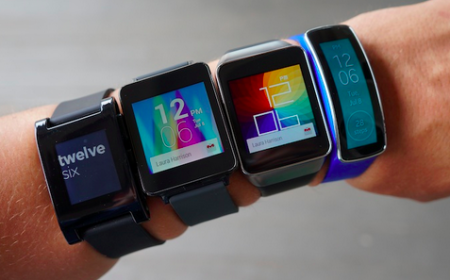The week in social: mobile video spending, wearables and Boomerang

Video accounted for 66% of mobile ad budgets in Q3
A new study from mobile analytics platforms AppLovin and AppsFlyer shows that mobile video spending has made leaps this year. With video being a major player in encouraging return users, and retention becoming one of the most important factors in the mobile space, video spending increased from 32% in Q1 to 66% in Q3. The study also showed that video ads garner better retention for apps than non-video ads, and that video ads served on iOS performed 10% better than ads served on Android devices.

Read more at Social Times
Study shows that Millennials chase opportunity via technology
While some members of older generations worry about the impact of technology in their lives, this year’s Webby Report shows that nine out of ten Millennials believe that technology and the Internet give them access to the kinds of jobs and futures they are suited to. Out of 2000 adults surveyed, all of them admitted that technology helped them to connect with friends and loved ones, but that connections forged in the online realm are less meaningful and that it will only get worse. The White Paper explores how the rapid advancements of the internet age are changing the way we live, work and interact with the world.
See the finding at Webby Awards
National Geographic named #1 brand on social media
Another story of video leading the times on social, new data from Shareablee shows that the brands who fared best on social media in Q3 are the brands with a strong video game. After analyzing 19.8 billion social actions – likes, shares, comments, retweets, favorites – across Facebook, Twitter and Instagram from July 1 to September 30, National Geographic came out on top with close to half a billion social actions across all platforms.

Read more on Social Times
Brands are throwing out content from Instagram’s Boomerang app
Less than a week after Instagram’s Boomerang app was launched, brands like Benefit Cosmetics, Plated, Gold’s Gym, Refinery 29 and Coca-Cola are getting onboard creating content for their social pages. The video app lets users turn everyday moments into not-so-everyday moments, taking a burst of photos and stitching them together to create a mini-video that plays forward and backward.

Read more at Instagram’s blog
Wearable technology usage on the rise
According to eMarketer’s first wearables forecast, 2015 will see 39.5 million adults donning wearable technology like smartwatches to fitness trackers. Looking toward the coming several years, this number is set to double with almost two in five internet users using wearables by 2019. What is now a younger and female skewed market, is slowly becoming more male dominated and will see ages of wearers rise as more health-related items are released. In addition, availability of major social apps on wearable technology has increased adoption as functionality increases.

Read more at eMarketer
Facebook beating Google in the click-through game
Facebook’s advertisers can know they made good choices after the release of the latest research from Adobe Digital Index. Findings show that Facebook ads are the most clicked on the internet, and are only rising. The study also revealed that Facebook’s ad impressions rose 10% in Q3, that it topped the list of revenue per visit at $1.24, and that it continues to hold off Google in terms of growth of click-through rates.
Read more at CMO
Brands are using Marquee to reach the masses
Instagram’s Marquee is giving brands the opportunity to reach millions with high-impact, single day advertising. Marquee’s blast advertisements have proved ideal for brands like Sony Mobile Hong Kong and Universal Pictures, spreading the word around premieres, product launches and key moments. Available in 26 countries, it gives brands the ability to target by country, and choose between video, photo, carousel and link ad formats to tell their story.
Read more on the Instagram blog
Skype adds new features to Skype for Android, iPhone and iPad
Following on from the release of Mojis, Skype Translator and a new range of emoticons, Skype has recently launched new video message filters in Skype for Android, iPhone and iPad. When sending video messages, users can now tap a button on the screen to choose between filters. As well as this, iPhone 6S and iPhone 6S Plus users can now take advantage of 3D Touch functionality within the app and at their device home screen.
Read more on the Skype blog
Snapchat updates terms of service
Snapchat recently followed in Facebook and Instagram’s footsteps, updating its terms of service in relation to user content uploaded through the app. As was the case with Instagram’s previous privacy amends, this caused a groundswell of rumour and speculation about privacy on the platform.

In the statement, Snapchat clarified its position on privacy and assured users that they were not storing user content indefinitely stating the following on their blog on the 1st November.
“First off, we want to be crystal clear: The Snaps and Chats you send your friends remain as private today as they were before the update. Our Privacy Policy continues to say—as it did before—that those messages “are automatically deleted from our servers once we detect that they have been viewed or have expired.” Of course, a recipient can always screenshot or save your Snaps or Chats. But the important point is that Snapchat is not—and never has been—stockpiling your private Snaps or Chats. And because we continue to delete them from our servers as soon as they’re read, we could not—and do not—share them with advertisers or business partners.
It’s true that our Terms of Service grant us a broad license to use the content you create—a license that’s common to services like ours. We need that license when it comes to, for example, Snaps submitted to Live Stories, where we have to be able to show those Stories around the world—and even replay them or syndicate them (something we’ve said we could do in previous versions of our Terms and Privacy Policy). But we tried to be clear that the Privacy Policy and your own privacy settings within the app could restrict the scope of that license so that your personal communications continue to remain truly personal.”
Read more at Social Times